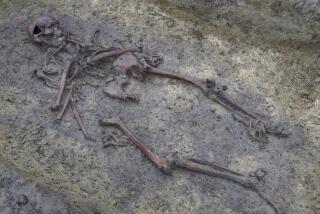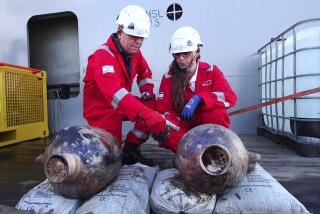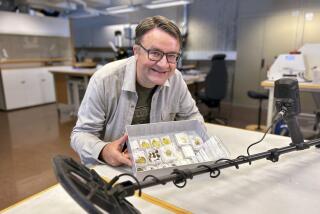Ancient Viking Shipyard Yields a Wealth of Artifacts, Insights Into Boat-Building
- Share via
COPENHAGEN — A Viking shipyard unearthed in southern Denmark is giving archeologists new insights into boat-building techniques of 1,000 years ago.
Excavations started in 1982 after a farmer’s bulldozer struck a mass of blackened wooden ship parts on the Danish southern Baltic island of Falster.
Archeologists have since uncovered the biggest Viking shipyard ever found in Scandinavia over a 370-acre marsh area near the hamlet of Noerre Snekkebjerg. In Viking times the site, which today lies 1 mile from the sea, was on a fiord.
Some 1,700 artifacts have been excavated so far and archeologists reckon that they still have years of work ahead.
“The evidence shows that ships were built, repaired and broken up at the shipyard from around 1050 to 1100 AD,” said Jan Skamby Madsen, curator at Denmark’s Viking Ship Museum and one of the archeologists leading the excavations.
“The finds at Noerre Snekkebjerg-- snekke is significantly an old Danish word for ship--represent an incredible treasure trove for marine archeologists. It is as far as I know the first Viking shipyard of the period ever unearthed,” he said.
Only one other Viking shipyard has been discovered in Scandinavia, an earlier but much smaller one on the Swedish island of Gotland, Skamby Madsen said.
So far the shipyard site has yielded a wealth of artifacts including piles of tools, shackle pins and brackets, wedges, rope fragments, hull ribs, rudder frames, joists and planking held together by wooden rivets. A mass of pottery and wood shavings were found littered over the site along with an ancient hornpipe, an earring and a splendid bronze sheath.
Experts say the abundance of spare parts is because of a shortage of oak for building new ships in the late Viking period. It also indicates the size and importance of the Falster yard.
“Usable spare parts were salvaged from scrapped vessels for recycling in new ships and repair jobs,” Skamby Madsen said.
The use of oak rivets, rather than the iron nails traditionally used by Nordic Vikings, points to the presence or influence of Wends--a Slavonic people who inhabited northern Germany in the early Middle Ages, he said.
“Contrary to what history books say, the Wends were not always at war with the Danish Vikings,” he said. “They were often allies and were probably given land in Falster in return for allegiance to the ancient Danish kings.”
The latest tree-dating techniques and the pottery finds date the site to about the 11th Century and there is evidence that the shipyard built big warships. High phosphate counts, usually associated with human and animal remains, in soil samples taken near the site indicate that there were possibly two ancient settlements connected with the yard.
Archeologists think that ships built at the yard resembled the five 11th-Century Viking vessels raised from a Danish fiord in the 1960s and on permanent exhibition at the Viking Ship Museum at Roskilde, west of Copenhagen.
“The Vikings produced dozens of different types of vessels at a high level of professionalism,” Skamby Madsen said.
“During the whole era of the sailing ship no better square-rigged ships were built than Viking ships.”
More to Read
Sign up for Essential California
The most important California stories and recommendations in your inbox every morning.
You may occasionally receive promotional content from the Los Angeles Times.










